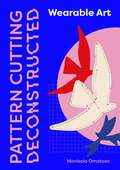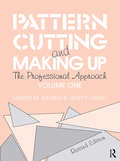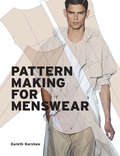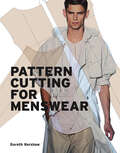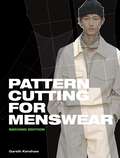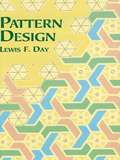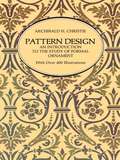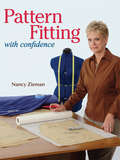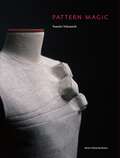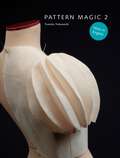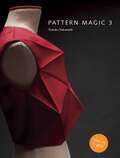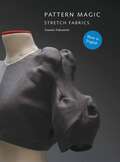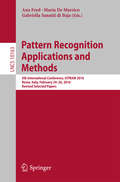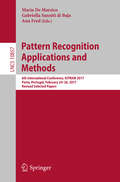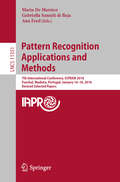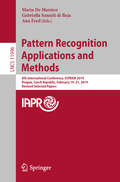- Table View
- List View
Pattern Cutting Deconstructed: Wearable Art
by Monisola OmotosoShape, form, colour and line are the visual language of abstract art and the inspiration for the designs in this creative pattern cutting book. Taking paintings by influential international artists from the early 20th century to the current day - from Matisse to Turner Prize winner Lubaina Himid - as her starting point, fashion designer and educator Monisola Omotoso offers an exciting alternative approach to developing patterns and draping on the dress form. Just as abstract art transforms reality, abstract art can be transformed into real, wearable fashion pieces.Each project begins with a work of art and a short text about the artist. The author then guides the reader through an illustrated step-by-step description of the pattern drafting and draping process of creating a garment inspired by the art.
Pattern Cutting and Making Up
by Janet Ward Martin ShobenMajor changes have occurred in the last few years in the methods of cutting and manufacturing outerwear. Light clothing companies are now manufacturing these heavy garments because of the development of fusible interlinings and new manufacturing techniques which have resulted in the deskilling of traditional tailoring methods. Outerwear has consquently assumed much greater importance in light clothing courses and this book - the first of its kind - has been written to reflect these industrial changes. It offers a course of practical and theoretical study which is related to specific garment types and fabrics. An essential manual for students at every level. Suitable for use in CGLI, BTEC and degree courses, this uniquely comprehensive work is certain to become a standard textbook on its subject.
Pattern Cutting for Menswear
by Gareth KershawDesigned for both students and professionals, this book offers a comprehensive guide to patternmaking for menswear from the basic skills through to more advanced techniques. The book includes 20 complete patterns that show how to cut every aspect of the menswear including adaptations from basic slopers through to classic garments and trend-led styles. Using a step-by-step approach, illustrated with accurately sized and scaled flat diagrams, technical flats and fashion illustrations, and photographs of muslins, it explains the theory behind the practice enabling the reader to understand how to cut patterns with confidence. Illustrated throughout, this book contains everything you need to know to make patterns for today’s menswear market.
Pattern Cutting for Menswear
by Gareth KershawDesigned for both students and professionals, Pattern Cutting for Menswear offers a comprehensive guide to pattern cutting from the basic skills through to advanced techniques. Including 20 complete patterns that show how to cut every aspect of menswear, the book features adaptations from basic blocks through to classic garments and trend-led styles. Illustrated throughout, this book contains everything you need to know to cut patterns for today’s menswear market. Using a step-by-step approach, illustrated with accurately sized and scaled flat diagrams, technical flats and fashion illustrations and photographs of toiles, Pattern Cutting for Menswear explains the theory behind the practice, enabling the reader to cut patterns with confidence.
Pattern Cutting for Menswear
by Gareth KershawDesigned for both students and professionals, this book offers a comprehensive guide to patternmaking for menswear from the basic skills through to more advanced techniques. The book includes 20 complete patterns that show how to cut every aspect of the menswear including adaptations from basic slopers through to classic garments and trend-led styles. Using a step-by-step approach, illustrated with accurately sized and scaled flat diagrams, technical flats and fashion illustrations, and photographs of muslins, it explains the theory behind the practice enabling the reader to understand how to cut patterns with confidence. Illustrated throughout, this book contains everything you need to know to make patterns for today’s menswear market.
Pattern Cutting for Menswear
by Gareth KershawDesigned for both students and professionals, Pattern Cutting for Menswear offers a comprehensive guide to pattern cutting from the basic skills through to advanced techniques. Including 20 complete patterns that show how to cut every aspect of menswear, the book features adaptations from basic blocks through to classic garments and trend-led styles. Illustrated throughout, this book contains everything you need to know to cut patterns for today’s menswear market. Using a step-by-step approach, illustrated with accurately sized and scaled flat diagrams, technical flats and fashion illustrations and photographs of toiles, Pattern Cutting for Menswear explains the theory behind the practice, enabling the reader to cut patterns with confidence.
Pattern Cutting for Menswear: Second Edition
by Gareth KershawPattern Cutting for Menswear is a comprehensive guide to cutting patterns, from basic skills to advanced techniques. With over twenty complete patterns, including new jacket and trouser styles, this revised edition features additional sections on the leg stride relationship in the development of certain trouser styles, fabric properties and their effect on cut and drape, fitting techniques for structured jackets, and the latest information on pattern CAD-based technologies. The step-by-step approach, complete with scaled diagrams and technical flats, fashion illustrations and photographs of toiles, enables you to cut patterns with confidence.
Pattern Cutting for Menswear: Second Edition
by Gareth KershawPattern Cutting for Menswear is a comprehensive guide to cutting patterns, from basic skills to advanced techniques. With over twenty complete patterns, including new jacket and trouser styles, this revised edition features additional sections on the leg stride relationship in the development of certain trouser styles, fabric properties and their effect on cut and drape, fitting techniques for structured jackets, and the latest information on pattern CAD-based technologies. The step-by-step approach, complete with scaled diagrams and technical flats, fashion illustrations and photographs of toiles, enables you to cut patterns with confidence.
Pattern Cutting: Second Edition
by Dennic Chunman LoThis practical guide explains how to take accurate measurements, introduces key tools and takes you from simple pattern-cutting ideas to more advanced creative methods. Step-by-step illustrations show how to create and then fit basic bodice, sleeve, skirt, dress, and trouser blocks, and how to adapt these to create patterns for original designs. New material includes advice on fitting toiles and working with stretch fabrics. There is also a fully updated chapter dedicated to digital technology.New to this edition: Access to 32 instructional videos
Pattern Cutting: Second Edition
by Dennic Chunman LoThis practical guide explains how to take accurate measurements, introduces key tools and takes you from simple pattern-cutting ideas to more advanced creative methods. Step-by-step illustrations show how to create and then fit basic bodice, sleeve, skirt, dress, and trouser blocks, and how to adapt these to create patterns for original designs. New material includes advice on fitting toiles and working with stretch fabrics. There is also a fully updated chapter dedicated to digital technology.New to this edition: Access to 32 instructional videos
Pattern Design
by Lewis F. DayTake any form you choose and repeat it at regular intervals, and, just as repetitive sounds produce rhythm or cadence, you have pattern. However, the use of pattern in design is no haphazard matter, but a disciplined activity in which the artists must impose a pleasing order and structure on the whole to achieve an aesthetically satisfying end product.This classic guide, revised and expanded by Amor Fenn three decades after its publication, teaches artists to do just that. Surveying a multitude of applications, from architectural detail to decorative textile printing and typographic patterns, Day provides insight into the geometric foundations of all repeating patterns, and treats in a practical way the anatomy, planning, and evolution of repeated ornament. He demonstrates the extent to which pattern is the essence of the ornamental arts, and offers a wealth of technical information for the student and designer.Generously illustrated with more than 270 designs ranging from old Japanese, Persian, and Arabian patterns to early 20th-century motifs, Pattern Design will stimulate the imaginations and advance the skills of novices and experts alike.
Pattern Design: An Introduction to the Study of Formal Ornament
by Archibald H. ChristieApproaching the study of design from a structural point of view, this classic handbook tells the designer how to construct hundreds of patterns from all periods and styles. Dr. Christie analyzes the elemental composition of patterns, and shows how coherent organization is achieved in each of the patterns he describes and illustrates. He then establishes basic principles, derived from the unity of all great ornament, which, if followed, will assure the success of any design.In the opening chapters the author describes various basic methods of organizing ornament, and explains the formal classification of ornament into distinct categories. He covers the six major categories of design separately, showing how numerous variations are made: traditional plant and animal devices; realistic plants and animals; straight striped patterns; waved and chevron striped patterns; cross-band patterns; and interlaced and counterchanged cross-band patterns. In another chapter he shows how some isolated devices of formal design -- granular texturings, disk and ring devices, arabesques, and more -- are constructed. He shows how design is created by rhythmic expansion -- how an element like a spiral or a swastika, for example, can be expanded in horizontal, vertical, and diagonal progressions to create the rhythmic scheme that constitutes a formal design.The book contains more than 400 illustrations, including the author's drawing of designs as well as photographs of actual patterns in textiles, ceramics, jewelry, and more -- a wealth of valuable pictorial material that is not readily available. As a unified discussion of the nature of patterns, this book will be of great interest to anyone concerned with handicrafts or the fine arts.
Pattern Fitting With Confidence: Sew, Serge And Pattern Fit With Confidence!
by Nancy ZiemanNancy Zieman's pattern fitting approach is easy - no cutting, slashing, tucking or pinching-just logical and easy pivot-and-slide techniques, providing a painless method to follow that results in a garment that is comfortable and attractive. Once you learn Nancy's techniques for fitting, you will find it easy to make every garment you sew fit your size and shape. Multiple fitting charts are included in the book, as well as an index for locating technical information at a glance.
Pattern Magic
by Tomoko NakamichiPattern Magic is the cult pattern-cutting book from Japan. Taking inspiration from nature, from geometric shapes and from the street, this book harnesses the sheer joy of making and sculpting clothes. Pattern Magic takes a creative approach to pattern cutting, with step-by-step projects for fashion designers and dressmakers to enjoy. All the basic information you need to start pattern cutting is included, from the basic block to measurements and scaling. Each project is beautifully illustrated with clear diagrams and photographs showing the stages of construction, the toiles and the finished garments. These easy-to-follow illustrations and detailed instructions make it easy to create stunning, sculptural clothes with a couture look.Step-by-step projects for fashion designers and dressmakers - with clear diagrams and photographs.Gives all the basic information needed to start pattern cutting: from the basic block to measurements and scaling.Easy-to-follow, detailed instructions make it easy to create stunning, sculptural clothes with a couture lookReviews for Pattern Magic:'The feeling of figuring the puzzle out makes this book series a joy to explore' House of Pinheiro'If you've mastered the basics of pattern cutting, have caught the bug and are eager to experiment with complex 3d designs, you should definitely take a look at Pattern Magic' Tilly And The Buttons Blog'I've had an explosion of inspiration, and I'm not even an expert in sewing!...I'm sure that many of you, fashion designers or not, can learn a lot from these tutorials' ImaginativeBloom.comCONTENTS:Part 1: Creating form through inspiration:Accents, Gathered hole, Crater, The drop hole, Lumps and bumpsPart 2: Making patterns for haute couture garments:Draped design, The twist, Hide and seek, Interwoven design, Bamboo shoot, The knot, Two distinct expressions, An intriguing curve, Bunka-style sloper (block) for an adult woman, Bunka-style sloper (block) for an adult woman (Size M) (half-scale)
Pattern Magic
by Tomoko NakamichiPattern Magic is the cult pattern-cutting book from Japan. Taking inspiration from nature, from geometric shapes and from the street, this book harnesses the sheer joy of making and sculpting clothes. Pattern Magic takes a creative approach to pattern cutting, with step-by-step projects for fashion designers and dressmakers to enjoy. All the basic information you need to start pattern cutting is included, from the basic block to measurements and scaling. Each project is beautifully illustrated with clear diagrams and photographs showing the stages of construction, the toiles and the finished garments. These easy-to-follow illustrations and detailed instructions make it easy to create stunning, sculptural clothes with a couture look.Step-by-step projects for fashion designers and dressmakers - with clear diagrams and photographs.Gives all the basic information needed to start pattern cutting: from the basic block to measurements and scaling.Easy-to-follow, detailed instructions make it easy to create stunning, sculptural clothes with a couture lookReviews for Pattern Magic:'The feeling of figuring the puzzle out makes this book series a joy to explore' House of Pinheiro'If you've mastered the basics of pattern cutting, have caught the bug and are eager to experiment with complex 3d designs, you should definitely take a look at Pattern Magic' Tilly And The Buttons Blog'I've had an explosion of inspiration, and I'm not even an expert in sewing!...I'm sure that many of you, fashion designers or not, can learn a lot from these tutorials' ImaginativeBloom.comCONTENTS:Part 1: Creating form through inspiration:Accents, Gathered hole, Crater, The drop hole, Lumps and bumpsPart 2: Making patterns for haute couture garments:Draped design, The twist, Hide and seek, Interwoven design, Bamboo shoot, The knot, Two distinct expressions, An intriguing curve, Bunka-style sloper (block) for an adult woman, Bunka-style sloper (block) for an adult woman (Size M) (half-scale)
Pattern Magic 2
by Tomoko NakamichiPattern Magic 2 is the follow up to the best-selling Pattern Magic. This series takes the cult pattern-cutting text from Japan and gives the reader an easy-to-follow guide to creating stunning, sculptural garments with a couture feel. Inspiring and exciting, this volume takes a creative approach to pattern cutting with more step-by-step projects for fashion designers and dressmakers to enjoy.This book looks at creating interesting surfaces, optical illusions and curved shapes through pattern cutting. All the basic information you need to start pattern cutting is included, from the basic block to measurements and scaling. Each project is beautifully illustrated with clear diagrams and photographs showing the stages of construction, the muslins (toiles) and the finished garments. The 200 illustrations and detailed instructions make it easy to create stunning, sculptural clothes.Review for Pattern Magic 2:'A super useful thing I found in these books is that EACH of the projects shown has its own tutorial with text, measurements and step by step images that show you how to create the paper pattern. This allow you to learn new sewing techniques.' Imaginativebloom.comCONTENTS:Using this bookFundamentalsPart 1: Playing with GeometricsWearing a balloon; wearing a circle; wearing a triangle; wearing a square; sprouting at the back; sprouting at the front; just like a stole; a ball-shaped accordion; circular accordion; circular sleeve; square accordionPart 2: Decorative structuresKnots; like a jungle; stars; flip turn; different facings, different looks; cowl neck; application of the cowl-neck designPart 3: It vanished...A vanishing scarf; a vanishing tie; a vanishing lapel; a vanishing pocketBunka-style sloper for an adult womanBunka-style sloper for an adult woman (size M) (half-scale)*The dress form used as the basis for the designs in this book is the Bunka-style sloper (block) for an adult Japanese woman. All patterns are for a size M Japanese woman (bust 83cm, waist 64cm, and centre back length 38cm). The position of the cutting and opening out lines, the allowances, and other measurements may vary according to garment size. If you are using the half-scale dress form, reduce the full-sized measurements on the drawings by half when you develop the patterns.For more Pattern Magic inspiration try the companion titles:Pattern MagicPattern Magic 3Pattern Magic: Stretch Fabrics
Pattern Magic 2
by Tomoko NakamichiPattern Magic 2 is the follow up to the best-selling Pattern Magic. This series takes the cult pattern-cutting text from Japan and gives the reader an easy-to-follow guide to creating stunning, sculptural garments with a couture feel. Inspiring and exciting, this volume takes a creative approach to pattern cutting with more step-by-step projects for fashion designers and dressmakers to enjoy.This book looks at creating interesting surfaces, optical illusions and curved shapes through pattern cutting. All the basic information you need to start pattern cutting is included, from the basic block to measurements and scaling. Each project is beautifully illustrated with clear diagrams and photographs showing the stages of construction, the muslins (toiles) and the finished garments. The 200 illustrations and detailed instructions make it easy to create stunning, sculptural clothes.Review for Pattern Magic 2:'A super useful thing I found in these books is that EACH of the projects shown has its own tutorial with text, measurements and step by step images that show you how to create the paper pattern. This allow you to learn new sewing techniques.' Imaginativebloom.comCONTENTS:Using this bookFundamentalsPart 1: Playing with GeometricsWearing a balloon; wearing a circle; wearing a triangle; wearing a square; sprouting at the back; sprouting at the front; just like a stole; a ball-shaped accordion; circular accordion; circular sleeve; square accordionPart 2: Decorative structuresKnots; like a jungle; stars; flip turn; different facings, different looks; cowl neck; application of the cowl-neck designPart 3: It vanished...A vanishing scarf; a vanishing tie; a vanishing lapel; a vanishing pocketBunka-style sloper for an adult womanBunka-style sloper for an adult woman (size M) (half-scale)*The dress form used as the basis for the designs in this book is the Bunka-style sloper (block) for an adult Japanese woman. All patterns are for a size M Japanese woman (bust 83cm, waist 64cm, and centre back length 38cm). The position of the cutting and opening out lines, the allowances, and other measurements may vary according to garment size. If you are using the half-scale dress form, reduce the full-sized measurements on the drawings by half when you develop the patterns.For more Pattern Magic inspiration try the companion titles:Pattern MagicPattern Magic 3Pattern Magic: Stretch Fabrics
Pattern Magic 3
by Tomoko NakamichiIn this new addition to the Pattern Magic series from Japan, Tomoko Nakamichi teaches you how to sculpt with fabric, creating beautiful shapes, waves and accents. Next, she looks at creating dynamic movement in garments, using ruffles, shirring and precise, sharply pleated lines.All the measurements and scaling information you need to start pattern making is included. As throughout the series, all the patterns are based on a basic block, supplied in the book. Thorough step-by-step instructions and diagrams will ensure that your own patterns translate beautifully to your choice of garment, while photographs of the finished garments will inspire you to create your own designs.
Pattern Magic 3
by Tomoko NakamichiIn this new addition to the Pattern Magic series from Japan, Tomoko Nakamichi teaches you how to sculpt with fabric, creating beautiful shapes, waves and accents. Next, she looks at creating dynamic movement in garments, using ruffles, shirring and precise, sharply pleated lines.All the measurements and scaling information you need to start pattern making is included. As throughout the series, all the patterns are based on a basic block, supplied in the book. Thorough step-by-step instructions and diagrams will ensure that your own patterns translate beautifully to your choice of garment, while photographs of the finished garments will inspire you to create your own designs.
Pattern Magic: Stretch Fabrics
by Tomoko NakamichiPattern Magic Stretch Fabrics is the third in the series of cult Japanese pattern cutting books, now translated into English. The new volume looks at working with stretch and jersey fabric. Material that stretches lengthways or sideways can be magical in itself. This book takes the special qualities of stretch fabrics and uses them to create stunning, sculptural designs. In two parts, the book shows how to work with stretch fabrics and how to cut patterns that exploit their properties with truly original results. The book is accompanied by a basic paper pattern block.
Pattern Magic: Stretch Fabrics
by Tomoko NakamichiPattern Magic Stretch Fabrics is the third in the series of cult Japanese pattern cutting books, now translated into English. The new volume looks at working with stretch and jersey fabric. Material that stretches lengthways or sideways can be magical in itself. This book takes the special qualities of stretch fabrics and uses them to create stunning, sculptural designs. In two parts, the book shows how to work with stretch fabrics and how to cut patterns that exploit their properties with truly original results. The book is accompanied by a basic paper pattern block.
Pattern Recognition Applications and Methods: 5th International Conference, ICPRAM 2016, Rome, Italy, February 24-26, 2016, Revised Selected Papers (Lecture Notes in Computer Science #10163)
by Ana Fred, Maria Marsico and Gabriella Sanniti di BajaThis book contains revised and extended versions of selected papers from the 5th International Conference on Pattern Recognition, ICPRAM 2016, held in Rome, Italy, in February 2016.The 13 full papers were carefully reviewed and selected from 125 initial submissions and describe up-to-date applications of pattern recognition techniques to real-world problems, interdisciplinary research, experimental and/or theoretical studies yielding new insights that advance pattern recognition methods.
Pattern Recognition Applications and Methods: 6th International Conference, ICPRAM 2017, Porto, Portugal, February 24–26, 2017, Revised Selected Papers (Lecture Notes in Computer Science #10857)
by Ana Fred Maria De Marsico Gabriella Sanniti di BajaThis book contains revised and extended versions of selected papers from the 6th International Conference on Pattern Recognition, ICPRAM 2017, held in Porto, Portugal, in February 2017. The 13 full papers presented were carefully reviewed and selected from 139 initial submissions. They aim at making visible and understandable the relevant trends of current research on pattern recognition.
Pattern Recognition Applications and Methods: 7th International Conference, ICPRAM 2018, Funchal, Madeira, Portugal, January 16-18, 2018, Revised Selected Papers (Lecture Notes in Computer Science #11351)
by Ana Fred Maria De Marsico Gabriella Sanniti di BajaThis book contains revised and extended versions of selected papers from the 7th International Conference on Pattern Recognition, ICPRAM 2018, held in Porto, Portugal, in January 2018. The 10 full papers presented were carefully reviewed and selected from 102 initial submissions.The core of ICPRAM is intended to include theoretical studies yielding new insights in Pattern Recognition methods, as well as experimental validation and concrete application of Pattern Recognition techniques to real-world problems.
Pattern Recognition Applications and Methods: 8th International Conference, ICPRAM 2019, Prague, Czech Republic, February 19-21, 2019, Revised Selected Papers (Lecture Notes in Computer Science #11996)
by Ana Fred Maria De Marsico Gabriella Sanniti di BajaThis book contains revised and extended versions of selected papers from the 8th International Conference on Pattern Recognition, ICPRAM 2019, held in Prague, Czech Republic, in February 2019. The 25 full papers presented together 52 short papers and 32 poster sessions were carefully reviewed and selected from 138 initial submissions. Contributions describing applications of Pattern Recognition techniques to real-world problems, interdisciplinary research, experimental and/or theoretical studies yielding new insights that advance Pattern Recognition methods are especially encouraged.
